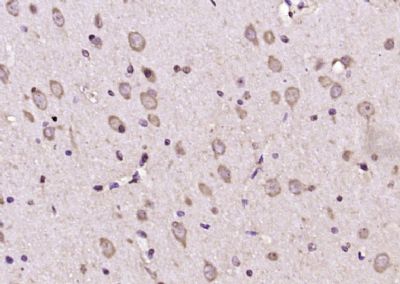产品货号 : mlR22025
英文名称 : Glypican 6
中文名称 : 磷脂酰基醇蛋白聚糖-6抗体
别 名 : GPC 6; Glypican6; Glypican-6; Glypican 6 [Precursor]; Glypican proteoglycan 6; GPC 6; GPC6; MGC126288; Secreted glypican 6.
研究领域 : 细胞生物 免疫学 信号转导 生长因子和激素 细胞表面分子 细胞骨架 锌指蛋白
抗体来源 : Rabbit
克隆类型 : Polyclonal
交叉反应 : Human, Mouse, Rat, Dog, Pig, Rabbit, Sheep,
产品应用 : ELISA=1:500-1000 IHC-P=1:400-800 IHC-F=1:400-800 ICC=1:100-500 IF=1:100-500 (石蜡切片需做抗原修复)
not yet tested in other applications.
optimal dilutions/concentrations should be determined by the end user.
分 子 量 : 56kDa
细胞定位 : 细胞膜 细胞外基质 分泌型蛋白
性 状 : Lyophilized or Liquid
浓 度 : 1mg/ml
免 疫 原 : KLH conjugated synthetic peptide derived from human Glypican 6 :131-230/555
亚 型 : IgG
纯化方法 : affinity purified by Protein A
储 存 液 : 0.01M TBS(pH7.4) with 1% BSA, 0.03% Proclin300 and 50% Glycerol.
保存条件 : Store at -20 °C for one year. Avoid repeated freeze/thaw cycles. The lyophilized antibody is stable at room temperature for at least one month and for greater than a year when kept at -20°C. When reconstituted in sterile pH 7.4 0.01M PBS or diluent of antibody the antibody is stable for at least two weeks at 2-4 °C.
PubMed : PubMed
产品介绍 : Glypican 6 is a putative cell surface coreceptor for growth factors, extracellular matrix proteins, proteases and anti proteases. The glypicans comprise a family of glycosylphosphatidylinositol anchored heparan sulfate proteoglycans. The glypicans have been implicated in the control of cell growth and division.
Function:
Cell surface proteoglycan that bears heparan sulfate. Putative cell surface coreceptor for growth factors, extracellular matrix proteins, proteases and anti-proteases.
Subcellular Location:
Cell membrane; Lipid-anchor, GPI-anchor; Extracellular side. Secreted glypican-6: Secreted, extracellular space.
Tissue Specificity:
Widely expressed. High expression in fetal kidney and lung and lower expressions in fetal liver and brain. In adult tissues, very abundant in ovary, high levels also observed in liver, kidney, small intestine and colon. Not detected in peripheral blood leukocytes.
DISEASE:
Defects in GPC6 are a cause of omodysplasia type 1 (OMOD1) [MIM:258315]. OMOD1 is a rare autosomal recessive skeletal dysplasia characterized by severe congenital micromelia with shortening and distal tapering of the humeri and femora to give a club-like appearance. Typical facial features include a prominent forehead, frontal bossing, short nose with a depressed broad bridge, short columella, anteverted nostrils, long philtrum, and small chin.
Similarity:
Belongs to the glypican family.
SWISS:
Q9Y625
Gene ID:
10082
Important Note:
This product as supplied is intended for research use only, not for use in human, therapeutic or diagnostic applications.
产品图片












